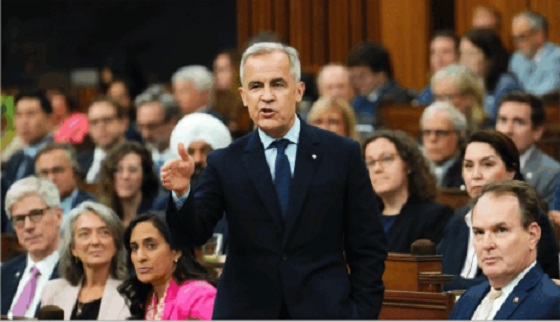Energy
Unleashing American Energy: America’s Silver Bullet

Energy Talking Points by Alex Epstein
|
|
It’s said that in politics there’s no silver bullet that’ll make everything better.
But we do have 1 silver bullet in the chamber: the opportunity to unleash American energy, which Donald Trump has rightly vowed to do.
- The single most important thing government can do to make our lives better—something that will lead to a better economy, a lower cost of living, more job opportunities, a lower deficit, greater security, and a better environment—is unleash abundant, affordable, American energy.
- If we unleash abundant, affordable, American oil, natural gas, and coal production from the anti-energy policies holding it back, we can go from crippling inflation—substantially driven by energy costs—to affordable food, housing, transportation, and heating bills.
- Unleashing American energy will take us from nationwide electricity shortages to affordable, reliable power for all—and from losing good job opportunities to China, which we’ve allowed to outcompete us on energy costs, to creating millions of new well-paying jobs here at home.
- Unleashing American energy will take us from begging OPEC+ for oil, depending on Russia for uranium, and being at China’s mercy for critical minerals, to producing an abundant and secure supply of these crucial commodities at home.
- Many Americans are hesitant to embrace policies that unleash abundant, affordable energy because they think it will harm environmental progress—progress in air and water quality, safety from climate, and enjoyment of nature. Nothing could be further from the truth.
- Environmental progress isn’t in conflict with abundant, affordable energy; it requires abundant, affordable energy—to afford pollution controls, to clean up natural environmental hazards, and to protect ourselves from the always-dynamic and dangerous climate.
- Thanks to abundant, affordable energy, America has been wealthy enough to innovate and adopt pollution controls that make our air far cleaner—which is why America was able to increase its fossil fuel use 25% since 1970 while reducing air pollution 78%.¹
- Thanks to abundant, affordable energy, America has been able to clean up natural environmental hazards such as undrinkable water, which requires affordable, reliable energy to purify, or mosquito-infested swamps, which require abundant, affordable energy to drain.
- Thanks to abundant, affordable energy, we can protect ourselves from the always-dangerous climate by powering heating and A/C systems, storm warning and evacuation systems, and irrigation systems; witness the 98% drop in climate-related disaster deaths over the last century.²
- Thanks to abundant, affordable energy we have the wealth we need to enjoy and preserve the most valuable and beautiful parts of nature—which is why America is able to be both the world’s economic superpower and a place of unsurpassed access to the great outdoors.
- The key to supporting America’s energy abundance and environmental progress is maintaining steadfast support of individual and economic freedom, including the protection of property rights.
- Property rights allow our energy companies to produce and innovate as they judge best. The shale revolution happened here because we alone protect underground property rights. Producers used this freedom to figure out how to extract abundant oil and gas from once-useless rocks.
- Property rights allow us to care for our environment on our own property—and people tend to care best for what they own. And property rights are the basis for laws protecting our air and water from dangerous levels of pollution.
- America has shown time and again that pro-freedom energy and environmental policies drive energy and environmental progress. And we can do it again, if we reverse the anti-freedom policies of the past several decades and embrace the following “energy freedom” policies.
- To aid America in unleashing American energy, I’ve created the Energy Freedom Plan—a comprehensive plan that includes hundreds of high-leverage policy changes for every aspect of energy, from drilling to pipelines to electricity to nuclear to rare earth elements.
- The Energy Freedom Plan is based on 5 game-changing goals:
- Unleash responsible development
- End preferences for unreliable electricity
- Set environmental standards using cost-benefit analysis
- Address climate danger through resilience and innovation
- Unleash nuclear energy
- Unleash responsible development
Anti-development policies prevent the drilling, mining, transporting, and building all energy needs to reach its potential—from natural gas to nuclear to solar.
Liberating responsible development will create unprecedented US energy abundance.
- End preferences for unreliable electricity
Our grid is being ruined by systemic preferences for unreliable electricity, which cause prices to rise and reliability to decline.
Ending these preferences and prioritizing reliability is needed to make power cheap and reliable again.
- Set environmental standards using cost-benefit analysis
The EPA harms prosperity and health via emissions standards that impose huge costs for little or no benefit.
Real cost-benefit analysis, including objective health science will promote prosperity and environmental quality.
- Address climate danger through resilience and innovation, not punishing America
“Climate policy”” that singles out US emissions makes us poorer and less resilient while global emissions go up.
Becoming more resilient and unleashing innovation are the keys to climate safety.
- Unleash nuclear energy from pseudo-scientific restrictions
The strangulation of nuclear has made it 10 times more expensive than it needs to be.
Unleashing nuclear, including getting rid of pseudoscientific policies like LNT and ALARA, will make possible a nuclear renaissance.
- This week I will be releasing the FULL Energy Freedom Plan, including over 100 SPECIFIC game-changing policies that can unleash American energy like never before.
To make sure you see the whole plan, follow me @AlexEpstein and especially subscribe to alexepstein.substack.com.
Questions about this article? Ask AlexAI, my chatbot for energy and climate answers:
Popular links
- EnergyTalkingPoints.com: Hundreds of concise, powerful, well-referenced talking points on energy, environmental, and climate issues.
- My new book Fossil Future: Why Global Human Flourishing Requires More Oil, Coal, and Natural Gas—Not Less.
- Speaking and media inquiries
“Energy Talking Points by Alex Epstein” is my free Substack newsletter designed to give as many people as possible access to concise, powerful, well-referenced talking points on the latest energy, environmental, and climate issues from a pro-human, pro-energy perspective.
Share Energy Talking Points by Alex Epstein
For every million people on earth, annual deaths from climate-related causes (extreme temperature, drought, flood, storms, wildfires) declined 98%–from an average of 247 per year during the 1920s to 2.5 per year during the 2010s.
Data on disaster deaths come from EM-DAT, CRED / UCLouvain, Brussels, Belgium – www.emdat.be (D. Guha-Sapir).
Population estimates for the 1920s from the Maddison Database 2010, the Groningen Growth and Development Centre, Faculty of Economics and Business at University of Groningen. For years not shown, population is assumed to have grown at a steady rate.
Population estimates for the 2010s come from World Bank Data.
Energy
Activists using the courts in attempt to hijack energy policy

2016 image provided by Misti Leon, left, sits with her mom, Juliana Leon. Misti Leon is suing several oil and gas companies in one of the first wrongful-death claims in the U.S. seeking to hold the fossil fuel industry accountable for its role in the changing climate.

From the Daily Caller News Foundation
By Jason Isaac
They twist yesterday’s weather into tomorrow’s crisis, peddle apocalyptic forecasts that fizzle, and swap “global warming” for “climate change” whenever the narrative demands. They sound the alarm on a so-called climate emergency — again and again.
Now, the Left has plunged to a new low: weaponizing the courts with a lawsuit in Washington State that marks a brazen, desperate escalation. This isn’t just legal maneuvering—it’s the exploitation of personal tragedy in service of an unpopular anti-energy climate crusade.
Consider the case at the center of a new legal circus: Juliana Leon, 65, tragically died of hyperthermia during a 100-mile drive in a car with broken air conditioning, as a brutal heat wave pushed temperatures to 108 degrees Fahrenheit.
Dear Readers:
As a nonprofit, we are dependent on the generosity of our readers.
Please consider making a small donation of any amount here.
Thank you!
The lawsuit leaps from this heartbreaking event to a sweeping claim: that a single hot day is the direct result of global warming.
The lawsuit preposterously links a very specific hot weather event to theorized global warming. Buckle up—their logic is about to take a wild ride.
Some activist scientists have further speculated that what may be a gradual long-term trend of slight warming thought to be both cyclical and natural, might be possibly exacerbated by the release of greenhouse gases. Some of these releases are the result of volcanic activity while some comes from human activities, including the burning of oil, natural gas and coal.
Grabbing onto that last, unproven thread, the plaintiffs have zeroed in on a handful of energy giants—BP, Chevron, Conoco, Exxon, Phillips 66, Shell, and the Olympic Pipe Company—accusing them of causing Leon’s death. Apparently, these few companies are to blame for the entire planet’s climate, while other oil giants, coal companies, and the billions of consumers who actually use these fuels get a free pass.
Meanwhile, “climate journalists” in the legacy media have ignored key details that will surely surface in court. Leon made her journey in a car with no air conditioning, despite forecasts warning of dangerous heat. She was returning from a doctor’s visit, having just been cleared to eat solid food after recent bariatric surgery.
But let’s be clear: this lawsuit isn’t about truth, justice, or even common sense. It’s lawfare, plain and simple.
Environmental extremists are using the courts to hijack national energy policy, aiming to force through a radical agenda they could never pass in Congress. A courtroom win would mean higher energy prices for everyone, the potential bankruptcy of energy companies, or their takeover by the so-called green industrial complex. For the trial lawyers, these cases are gold mines, with contingency fees that could reach hundreds of millions.
This particular lawsuit was reportedly pitched to Leon’s daughter by the left-leaning Center for Climate Integrity, a group bankrolled by billionaire British national Christopher Hohn through his Children’s Investment Fund Foundation and by the Rockefeller Foundation. It’s yet another meritless claim in the endless list of climate lawsuits that are increasingly being tossed out of courts across the country.
Earlier this year, a Pennsylvania judge threw out a climate nuisance suit against oil producers brought by Bucks County, citing lack of jurisdiction. In New York, Supreme Court Justice Anar Patel dismissed a massive climate lawsuit by New York City, pointing out the city couldn’t claim both public awareness and deception by oil companies in the same breath.
But the Washington State case goes even further, threatening to set a dangerous precedent: if it moves forward, energy companies could face limitless liability for any weather-related injury. Worse, it would give unwarranted credibility to the idea — floated by a leftwing activist before the U.S. Senate — that energy executives could be prosecuted for homicide, a notion that Republican Texas Sen. Ted Cruz rightly called “moonbeam, wacky theory.”
The courts must keep rejecting these absurd lawfare stunts. More importantly, America’s energy policy should be set by Congress—elected and accountable—not by a single judge in a municipal courtroom.
Jason Isaac is the founder and CEO of the American Energy Institute. He previously served four terms in the Texas House of Representatives.
Alberta
Temporary Alberta grid limit unlikely to dampen data centre investment, analyst says
From the Canadian Energy Centre
By Cody Ciona
‘Alberta has never seen this level and volume of load connection requests’
Billions of investment in new data centres is still expected in Alberta despite the province’s electric system operator placing a temporary limit on new large-load grid connections, said Carson Kearl, lead data centre analyst for Enverus Intelligence Research.
Kearl cited NVIDIA CEO Jensen Huang’s estimate from earlier this year that building a one-gigawatt data centre costs between US$60 billion and US$80 billion.
That implies the Alberta Electric System Operator (AESO)’s 1.2 gigawatt temporary limit would still allow for up to C$130 billion of investment.
“It’s got the potential to be extremely impactful to the Alberta power sector and economy,” Kearl said.
Importantly, data centre operators can potentially get around the temporary limit by ‘bringing their own power’ rather than drawing electricity from the existing grid.
In Alberta’s deregulated electricity market – the only one in Canada – large energy consumers like data centres can build the power supply they need by entering project agreements directly with electricity producers.
According to the AESO, there are 30 proposed data centre projects across the province.
The total requested power load for these projects is more than 16 gigawatts, roughly four gigawatts more than Alberta’s demand record in January 2024 during a severe cold snap.
For comparison, Edmonton’s load is around 1.4 gigawatts, the AESO said.
“Alberta has never seen this level and volume of load connection requests,” CEO Aaron Engen said in a statement.
“Because connecting all large loads seeking access would impair grid reliability, we established a limit that preserves system integrity while enabling timely data centre development in Alberta.”
As data centre projects come to the province, so do jobs and other economic benefits.
“You have all of the construction staff associated; electricians, engineers, plumbers, and HVAC people for all the cooling tech that are continuously working on a multi-year time horizon. In the construction phase there’s a lot of spend, and that is just generally good for the ecosystem,” said Kearl.
Investment in local power infrastructure also has long-term job implications for maintenance and upgrades, he said.
“Alberta is a really exciting place when it comes to building data centers,” said Beacon AI CEO Josh Schertzer on a recent ARC Energy Ideas podcast.
“It has really great access to natural gas, it does have some excess grid capacity that can be used in the short term, it’s got a great workforce, and it’s very business-friendly.”
The unaltered reproduction of this content is free of charge with attribution to the Canadian Energy Centre.
-

 Business1 day ago
Business1 day agoMark Carney’s Fiscal Fantasy Will Bankrupt Canada
-

 Alberta1 day ago
Alberta1 day agoTemporary Alberta grid limit unlikely to dampen data centre investment, analyst says
-

 Opinion1 day ago
Opinion1 day agoCharity Campaigns vs. Charity Donations
-

 Frontier Centre for Public Policy2 days ago
Frontier Centre for Public Policy2 days agoCanada’s New Border Bill Spies On You, Not The Bad Guys
-

 Daily Caller20 hours ago
Daily Caller20 hours ago‘Strange Confluence Of Variables’: Mike Benz Wants Transparency Task Force To Investigate What Happened in Butler, PA
-

 Uncategorized2 days ago
Uncategorized2 days agoCNN’s Shock Climate Polling Data Reinforces Trump’s Energy Agenda
-

 Opinion1 day ago
Opinion1 day agoPreston Manning: Three Wise Men from the East, Again
-

 COVID-191 day ago
COVID-191 day agoTrump DOJ dismisses charges against doctor who issued fake COVID passports





